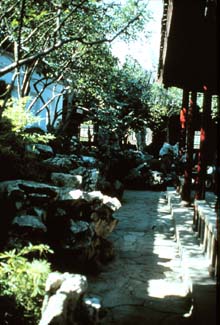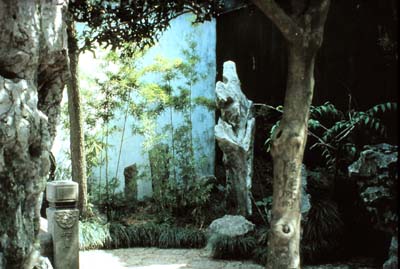

|
Buildings within the garden
|
|
|
|
What do you think inspired the names of the buildings in this garden?
For a birds' eye view of the Garden of the Master of Nets, click here.
The name of the Garden of the Master of Nets refers to one of the features below; can you guess which it might be?
|
|
|
|
|
| Now, let's start our tour. |
|
We'll start out by walking from the northeast entrance through a set of courtyards, to end up in the Branch Beyond Bamboo Viewing Porch (number 9 on our main map), just south of the library. From there we can look through a moon gate onto the central pond. |
||
|
Moon Gate, looking out through A Branch Beyond Bamboo viewing porch
|
||
|
Go a few steps further to catch a glimpse of the Barrier of Clouds Terrace. Do you think this is considered a good view of the building? Why are the rocks placed there?
|
|||
|
|||
|
|
But before we cross the garden to the other side of the pond, there is a small courtyard on the west side of the bridge . . . |
|
|
Three-step bridge from the southeast corner of the pond
|
|
At the lower end of the courtyard, a small pavilion (number 12 on the main map) sits up against the outer wall of the garden.
Does this seem different from other pavilions you've seen? Does it look like you could walk through this structure? |
|
|
Half-pavilion with Lake Tai rock
|
|
If we follow the long covered walkway that borders the west side of the pond to the south, we pass the Belvedere of Magnificent and Bright Waters (number 14). Just past this point, a crooked walkway veers off to the left; let's follow it towards the south end of the pond. . . |
|
From the back of this viewing porch (number 15) we can look out through "cracked ice" patterned windows to the northwest, with a view of rockery and bamboo (pictured below on the left). Step just outside the building on the south side to look at another courtyard (pictured below on the right). What types of activity do you think might have taken place in this particular courtyard?
|
|
|
 |
|||
|
View from the interior, Barrier of Clouds Hall |
||||
|
Courtyard south of Barrier of Clouds Hall
|
|
Go back through the building, and follow the walkway that turns to the right, then take the walkway that splits off on a sharp left. These walkways connect portions of the compound (numbers 1, 2, and 3 on the main map) that were originally the living quarters of the occupants. |
|
If we enter the courtyard to the west of the Great Hall (number 3), we find ourselves right next to the small bridge that we saw from the north side of the pond when we first started out. How do you think the available pathways and views of various parts of the garden affect the visitor's impression of the overall distance and size of the compound? |
||
|
Bridge looking across to the Gazing at Pines and Studying Paintings Studio
|
||
|
Looking back past the bridge, the pond quickly dwindles to the size of a small brook. What do you think is the function of the small sluice gate on the right below? |
|||
|
|
|
||
|
Pond "source"
|
Sluice gate at pond "source"
|
||
|
|||
|
Continue north along the pathway beside the pond. Just to the other side of the Tower of Gathered Excellence (number 4 on the main map) is a courtyard we haven't yet seen. This courtyard lies to the east of the Five Summits Reading Hut (number 5), which houses the owner's library on the second floor. If we stand in the middle of the courtyard facing north, a small path veers off to the right behind a rockery. |
|
 |
|
|
Northeast corner of library courtyard with black wall
|
|
Return to the middle of the courtyard. Face the building directly to the west. Where do you think this entrance leads?
(You may remember this view from the discussion on Rocks in the Garden).
|
||
|
||
|
|
|
|
Library courtyard with moon gate
|
|
Walk over to the southwest corner of the courtyard and look back at the moon gate. The tree that is framed within the circular gate is a cassia tree.
|
|||
|
|||
|
The moon and the cassia tree are closely linked in Chinese mythology. It is said that if you look closely at the moon's surface, you can see the woodcutter Wu Kang cutting down a cassia tree. Wu Kang was banished to the moon for his fixation on the magical aspects of immortality. The gods would allow him to return to earth only after chopping down the huge cassia tree that thrived alone on the moon. However, the tree has magical self-restorative properties, and so Wu Kang continues to chop for eternity. Why would a cassia tree and a moon be appropriate in a garden? |
|
Although we have now walked the circuit of the Master of Nets compound, and are back at the Northeast entrance, there are many features of the garden that we haven't had time to see. What features of this garden do you think might be typical of scholars' gardens in general? What do you think might be a main source of appeal of this garden? |